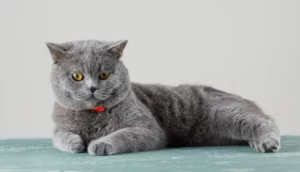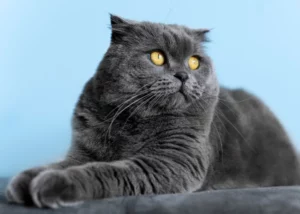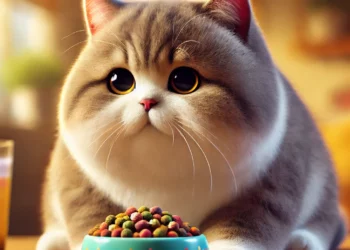
The British Shorthair or British Shorthair is a breed of cat that descends from the cross between the cats brought to Britain by the Romans and the natives of the island. These cats are very well protected from the British climate by their double and waterproof coat.
Summary
The British Shorthair is one of the oldest and most beloved cat breeds in the world. Known for their distinctive round faces, dense coats, and easygoing nature, these cats have earned a place in the hearts of cat lovers everywhere. Whether you’re already a British Shorthair owner or considering bringing one into your home, this comprehensive guide will provide you with everything you need to know about this charming breed.
History of the British Shorthair
Ancient Origins
The British Shorthair’s history is deeply rooted in British culture. Their ancestors are believed to have been brought to Britain by the Romans over 2,000 years ago. These early cats were likely Egyptian domestic cats that were prized for their hunting abilities. Over time, these cats bred with local wildcats, resulting in a sturdy, well-muscled cat that was well-adapted to the British climate.
Development of the Breed
In the late 19th century, British breeders began to standardize the breed, focusing on its robust body and dense, plush coat. The British Shorthair was officially recognized as a breed in 1871 when the first cat show took place at the Crystal Palace in London. Over the years, the breed has been refined, with the iconic blue-gray coat color becoming one of the most popular and recognizable traits.
Near Extinction and Revival
During the two World Wars, the British Shorthair population dwindled significantly due to food shortages and the harsh conditions of the time. However, dedicated breeders worked tirelessly to revive the breed, often crossing it with other breeds like Persians to reintroduce vitality. Today, the British Shorthair is one of the most popular cat breeds in the world, admired for its appearance and personality.
Physical Characteristics
Appearance and Size
The British Shorthair is a medium to large-sized cat, with males typically weighing between 12 to 18 pounds and females between 8 to 14 pounds. They have a muscular build with a broad chest, strong legs, and a thick, rounded tail. The most distinctive feature of the British Shorthair is its round face with full cheeks, large round eyes, and small, rounded ears. Their eyes are often copper or gold, particularly in the blue-coated variety, adding to their characteristic “teddy bear” look.
Coat and Colors
The British Shorthair’s coat is dense and plush, with a texture that feels somewhat like velvet. This breed is best known for its blue coat, which is a solid gray-blue color that gives the cat a regal and dignified appearance. However, British Shorthairs come in a wide variety of colors and patterns, including black, white, cream, red, silver, and even bicolor or tabby patterns.
The coat requires regular grooming, particularly during shedding seasons, to maintain its luster and prevent matting.
Personality and Temperament
Calm and Easygoing
British Shorthairs are known for their calm and easygoing nature. They are affectionate cats that enjoy spending time with their human companions, but they are not typically “lap cats.” Instead, they prefer to sit nearby or in the same room, providing quiet companionship without being overly demanding.
These cats are relatively low-energy, especially compared to more active breeds like the Abyssinian or Bengal. They enjoy lounging around the house but will also have bursts of playful energy, especially when they are younger.
Independent but Affectionate
While British Shorthairs are independent, they are also very affectionate with their families. They tend to form strong bonds with their owners and enjoy gentle petting and interaction. These cats are typically good with children and other pets, making them an excellent choice for families.
British Shorthairs are not known to be particularly vocal, but they will communicate with soft, quiet meows when they need something. Their gentle and undemanding nature makes them ideal for people who want a loving companion without too much need for constant attention.
Interaction with Other Pets
The British Shorthair’s laid-back nature makes them well-suited to living in a multi-pet household. They generally get along well with other cats and dogs, especially if they are introduced to them gradually. Their calm demeanor means they are unlikely to be aggressive or overly territorial, but it’s always important to monitor interactions with other pets to ensure harmony.
Grooming and Maintenance
Coat Care
The British Shorthair’s dense coat does require regular grooming, particularly during the spring and fall shedding seasons. Brushing your cat once or twice a week will help remove loose hairs and keep the coat looking its best. A good grooming routine also reduces the likelihood of hairballs, which can be a common issue with this breed due to their thick fur.
During shedding seasons, you may need to increase the frequency of grooming to daily sessions to keep up with the extra hair. While British Shorthairs are generally very clean cats, occasional baths may be necessary, especially if they get into something messy or if their coat becomes oily.
Dental and Nail Care
Dental care is important for all cats, including the British Shorthair. Regular brushing with a cat-specific toothpaste will help prevent dental issues such as tartar buildup and gum disease. It’s also a good idea to schedule regular dental check-ups with your veterinarian.
Nail care is another essential aspect of grooming. Trim your British Shorthair’s nails every couple of weeks to prevent overgrowth and to keep them from becoming sharp. Providing scratching posts around your home will also help your cat maintain healthy nails and prevent them from scratching your furniture.
Diet and Nutrition
Nutritional Requirements
British Shorthairs have moderate activity levels, so their diet should be balanced to prevent obesity. It’s important to provide a diet rich in high-quality protein to support their muscular build and maintain healthy weight. Whether you choose to feed your cat dry kibble, wet food, or a combination of both, make sure the food is specifically formulated for their life stage—kitten, adult, or senior.
Portion Control
British Shorthairs are prone to overeating, especially if they lead a more sedentary lifestyle. It’s important to monitor their food intake and provide measured portions based on their weight, age, and activity level. Avoid free-feeding and instead offer meals at specific times each day. Your veterinarian can help you determine the right amount of food and the best feeding schedule for your cat.
Hydration
Like all cats, British Shorthairs need to stay well-hydrated. Wet food can help with this, as it contains a higher moisture content than dry kibble. Make sure your cat always has access to fresh, clean water. Some cats prefer running water, so consider providing a water fountain to encourage them to drink more.
Health and Lifespan
Common Health Issues
The British Shorthair is generally a healthy breed, but like all cats, they are prone to certain health issues. Some of the common conditions seen in this breed include:
- Hypertrophic Cardiomyopathy (HCM): This is a common heart condition in cats, where the heart muscle becomes abnormally thickened. Regular vet check-ups and echocardiograms can help detect HCM early.
- Obesity: Due to their relatively low energy levels, British Shorthairs are prone to weight gain if their diet and exercise are not carefully managed. Obesity can lead to other health issues, such as diabetes and joint problems.
- Polycystic Kidney Disease (PKD): This genetic condition causes cysts to form in the kidneys, leading to kidney dysfunction over time. Genetic testing can help identify PKD in breeding lines.
Lifespan
With proper care, British Shorthairs typically live between 12 to 20 years. Regular veterinary check-ups, a balanced diet, and plenty of love and attention will help ensure your British Shorthair leads a long, healthy life.
Tips for Living with a British Shorthair
Provide a Comfortable Environment
British Shorthairs appreciate a comfortable and secure environment. They enjoy having cozy spots where they can relax and observe their surroundings. Provide plenty of soft bedding, cat trees, and perches where your cat can retreat and feel safe.
Encourage Play and Exercise
While British Shorthairs are not the most active cats, they still need regular exercise to maintain a healthy weight and stay mentally stimulated. Interactive toys, laser pointers, and gentle play sessions can help keep them engaged. Encouraging your cat to chase toys or explore different parts of your home will also help prevent boredom.
Monitor Weight and Health
Due to their propensity for weight gain, it’s important to monitor your British Shorthair’s weight regularly. Use a scale to track their weight and adjust their diet as needed. Pay attention to any changes in behavior, appetite, or activity levels, as these can be early signs of health issues.
Regular Vet Visits
Regular veterinary care is essential for maintaining your British Shorthair’s health. Schedule annual or bi-annual check-ups to monitor their overall health and catch any potential issues early. Your vet can also provide guidance on vaccinations, dental care, and any specific health concerns related to the breed.
FAQs about British Shorthair Cats
Are British Shorthairs good with children?
Yes, British Shorthairs are known for their gentle and tolerant nature, making them excellent companions for families with children. They are patient and not easily stressed, which makes them well-suited to a busy household.
How much grooming do British Shorthairs require?
British Shorthairs have a dense, plush coat that requires regular grooming to keep it in top condition. Brushing once or twice a week is usually sufficient to remove loose hairs and reduce shedding. During shedding seasons (spring and fall), you may need to brush more frequently to manage the extra fur. Their coat is generally low-maintenance compared to long-haired breeds, but regular grooming helps prevent matting and keeps their fur looking its best.
Do British Shorthairs get along with other pets?
Yes, British Shorthairs typically get along well with other pets, including dogs and other cats. Their calm and laid-back nature makes them adaptable to various living situations. However, as with any introduction between pets, it’s important to do so gradually and monitor their interactions to ensure harmony in the household.
Are British Shorthairs indoor or outdoor cats?
British Shorthairs are best suited to indoor living due to their calm and somewhat sedentary nature. While they may enjoy supervised outdoor time, they are not as adventurous or active as some other breeds. Providing plenty of indoor enrichment, such as toys and scratching posts, can keep them happy and engaged without the need for outdoor exploration.
What health issues should I be aware of in British Shorthairs?
British Shorthairs are prone to certain health conditions, including Hypertrophic Cardiomyopathy (HCM), obesity, and Polycystic Kidney Disease (PKD). Regular veterinary check-ups, a balanced diet, and maintaining a healthy weight are key to preventing or managing these conditions. Genetic testing can also be helpful in identifying any inherited health risks.
How long do British Shorthairs live?
With proper care, British Shorthairs typically live between 12 to 20 years. Their longevity is a testament to their robust health, provided they are given a healthy diet, regular veterinary care, and plenty of love and attention.
Latest on CatOlympus
Effects Of Music On Cats: Do Cats Enjoy Music?
For many cat owners, music is a regular part of daily life. We play it while cooking, cleaning, relaxing, or...
Myths And Truths About Feeding Your Cat
Feeding your cat is more than just picking up the nearest bag of kibble. It’s about providing balanced nutrition to...
How To Ensure Your Cat Drinks Enough Water
Water is essential for life, and just like humans, cats need adequate hydration to maintain their health and well-being. However,...
How to Spot and Prevent Parasites In Cats
Parasites are an unfortunate but common issue that many cat owners will face at some point. These unwelcome visitors can...











